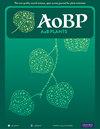交配系统、形态学和遗传学证据证明克隆性是亚马逊河流域雌雄异体的特有物种 Daphnopsis filipedunculata(胸腺藻科)的一种基本繁殖模式
IF 2.4
3区 生物学
Q2 ECOLOGY
引用次数: 0
摘要
背景与目的 克隆的特征是形成具有相同基因型的独立个体,这些个体能够进行无性繁殖和繁殖。虽然克隆是促进种群持续存在的重要机制,但由于资源投资的权衡,克隆的广泛使用可能会对有性生殖产生负面影响。因此,对表现出克隆性的物种的有性生殖进行研究,可以提供有关其对环境变化的适应能力、繁殖力、传粉媒介缺失的风险以及在不利条件下持续生存和成功占据新区域的能力等方面的信息。在这里,我们研究了Daphnopsis filipedunculata(百日草科)克隆繁殖和有性繁殖的作用,这是一种雌雄异株的物种,只分布在Serra dos Carajás。方法 我们利用分子工具和对负责发育新柱头的地下系统的解剖分析,评估了该物种的克隆程度。此外,我们还通过花型形态分析和实地授粉实验分析了有性系统及其对繁殖成功率的贡献。主要结果 总体而言,我们发现克隆繁殖在维持 D. filipedunculata 的种群数量方面发挥了重要作用。具体来说,我们证明了该物种具有功能性雌雄植株,这表明 D. filipedunculata 是一种强制性异花授粉物种,但繁殖成功率较低。我们还发现,克隆无性繁殖是该物种的主要无性繁殖形式,根系负责克隆生长。最后,我们的研究结果表明,该物种的克隆结构介于法氏囊和豚草之间。结论 我们的研究首次揭示了 D. filipedunculata 的有性生殖和克隆繁殖,可为管理实践、保护和恢复特有物种提供参考。本文章由计算机程序翻译,如有差异,请以英文原文为准。
Mating system, morphological, and genetic evidence endorse clonality as an essential reproductive mode in Daphnopsis filipedunculata (Thymelaeaceae), a dioecious and endemic species from the Amazon
Background and Aims Clonality is characterized by the formation of independent individuals of the same genotype that are capable of reproducing and propagating vegetatively. Although clonality is an important mechanism that facilitates the persistence of a population, its extensive use can lead to negative impacts on sexual reproduction due to trade-offs in the investment of resources. Therefore, studies on the sexual reproduction of species that exhibit clonality can provide information about resilience to environmental changes, information about fecundity, the risk of the absence of pollinators, and the ability to persist in unfavorable conditions and to successfully occupy new areas. Here, we investigated the role of clonal propagation and sexual reproduction in Daphnopsis filipedunculata (Thymelaeaceae), a dioecious species distributed only in Serra dos Carajás. Methods We evaluated the extent of clonality in this species using molecular tools and anatomical analyses of the underground system responsible for developing new ramets. Furthermore, we analyzed the sexual system and its contribution to reproductive success through morphometric analyses of floral types and pollination experiments in the field. Key Results Overall, we found that clonal propagation plays an important role in maintaining the population of D. filipedunculata. Specifically, we demonstrated that this species presents functional male and female plants, indicating that D. filipedunculata is an obligate xenogamous species but has low reproductive success. We also showed that clonal vegetative propagation is the main form of asexual reproduction in this species, with roots responsible for clonal growth. Finally, our results indicated that this species presents an intermediate phalanx-guerrilla clonal architecture. Conclusions Our study provides the first insights into sexual reproduction and clonal propagation in D. filipedunculata and can inform management practices, conservation, and the restoration of endemic species.
求助全文
通过发布文献求助,成功后即可免费获取论文全文。
去求助
来源期刊

AoB Plants
PLANT SCIENCES-
CiteScore
4.80
自引率
0.00%
发文量
54
审稿时长
20 weeks
期刊介绍:
AoB PLANTS is an open-access, online journal that has been publishing peer-reviewed articles since 2010, with an emphasis on all aspects of environmental and evolutionary plant biology. Published by Oxford University Press, this journal is dedicated to rapid publication of research articles, reviews, commentaries and short communications. The taxonomic scope of the journal spans the full gamut of vascular and non-vascular plants, as well as other taxa that impact these organisms. AoB PLANTS provides a fast-track pathway for publishing high-quality research in an open-access environment, where papers are available online to anyone, anywhere free of charge.
 求助内容:
求助内容: 应助结果提醒方式:
应助结果提醒方式:


